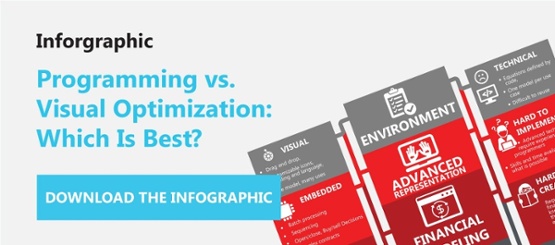Constraint-based modeling has been underutilized in many areas of the planning and decision-making process for one primary reason: using it is has been, historically, a laborious process due to the need for data scientists to write massive amounts of code. As a result, many companies use spreadsheets to produce their operational and strategic plans.
In fact, nearly 80 percent of businesses say spreadsheets are their planning tool of choice, since they don’t require a team of data scientists and are a much more comfortable tool for business analysts and planners.
However, spreadsheets don’t allow businesses to appropriately represent many of their cross-functional constraints. Or, if they do, they do so in a highly simplified manner. Why do constraints matter in supply chain management and logistics? To answer that question, let’s take a look at what constraint-based modeling means.
Constraint-Based Modeling Means Optimal Answers
Constraint-based modeling is defined as a proven mathematical approach in which the outcome of each decision is constrained by a minimum and maximum range of limits (+/- infinity is allowed).
In traditional use cases, constraint-based modeling has focused on removing bottlenecks, like those that inhibit supply chain throughput.
However, forward-thinking companies are finding that constraint-based modeling has another attribute, known as an opportunity value. Opportunity value is the optimal, net economic impact of an action or decision. When variables or constraints are relaxed, modelers are able to view broader “what if?” scenarios based on opportunity values. Thus, they can see the most profitable decisions—even those that are outside what business users might think is feasible.
Example: A manufacturing plant found that by adding an extra shift to one of its machines, it was able to generate an additional $10,000 per hour in profits, despite the increased labor costs.
Traditional planning systems—like those used for materials requirements, capacity, inventory or demand—cannot calculate the true bottom-line opportunity value associated with a constrained decision. The most impactful constraint-based modeling approach is one that calculates the opportunity value of the constrained decision.
Skills and Technology Needed
Technology with this type of intelligent, constraint-based modeling can absorb unlimited, granular details such as:
- Multiple locations
- Shifts, including workforce availability and level of expertise
- Functions, from procurement to customer
- Production lines (including changeovers)
- Costs, like raw materials, direct labor, variable overhead, and fixed overhead
- Granular details such as the difference in the throughput rates of machines
Constraint-based modeling is most useful when it’s available in technology that offers an easy-to-use, cloud-based interface. When this is the case, dozens of analysts or executives can run scenarios and collaborate on the different ways in which they can achieve certain operational goals (e.g., improving throughput rates, cutting costs, improving service levels) while still meeting high-level business objectives like profitability. They’re able to make 100 percent data-backed decisions as opposed to simply relying on “gut feeling” or incomplete/partial data.
As for skills, thanks to the rise of citizen data scientists, other business roles like marketing and sales can learn how to operate advanced analytics with built-in algorithms. This allows advanced analytics technology to do the heavy lifting and provide profound insights into the best possible outcomes.
Two other crucial components of constraint modeling technology are flexibility and speed. Companies need to quickly (in near real-time) run analyses that can give them an added advantage when they need to pivot to address sudden changes in external factors such as tariffs, rate hikes, and OPEC decisions.
With next-generation constraint-based approaches—which are able to show opportunity values and model an end-to-end business—optimization modeling goes beyond eliminating bottlenecks and actually reveals executable profit opportunities that might otherwise go unnoticed.
Here are a few customer examples, by industry, that demonstrate the value of next-generation constraint-based modeling.
Constraint-Based Modeling in a Code-Free Environment: Examples
Oil and Gas
| Objective: | Decisions must include the company’s core values of social responsibility and environmental sustainability. |
| Constraint: | Sourcing opportunities have environmental impacts, such as deforestation. |
| Optimized: | Consider the transportation costs of sourcing from different suppliers. |
| Outcome: | Make the best decisions for the company while respecting its core values. |
| Objective: | The company needs to deliver products efficiently while meeting contract delivery and costs. |
| Constraint: | Transportation mode (rail, barge, truck) and the type of payment (take or pay, percent minimums). |
| Optimized: | Logistics plans account for the demand under contract but also new, available contracts. |
| Outcome: | Near real-time access to validated, data-backed and optimal decisions that identify opportunities and better monetize transportation and inventory while meeting demand. |
Consumer Goods
| Objective: | Meet the demand for the most profitable products across all locations. |
| Constraint: | Production processes have per-line constraints that differ across plants. Transportation costs vary drastically by location. |
| Optimized: | Reduce material and transportation costs while increasing the number of changeovers across the entire network. |
| Outcome: | Allocate the right demand to the right location with fewer overall hours than before, significantly improving the company’s profits. |
Building Products
| Objective: | Meet demand in the most profitable way (per product) given constrained capacity and dynamic environments. |
| Constraint: | Variable capacities and shipping costs across all plants. |
| Optimized: | Optimize shipping methods, SKU substitutions, upgrade/downgrade trade-offs, and unexpected events like natural disasters. |
| Outcome: | Optimize production allocation for profit and plan strategically based on operational constraints and performance. |




